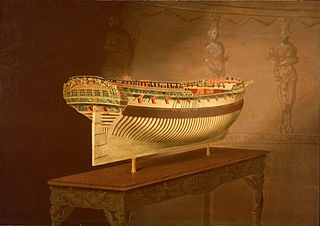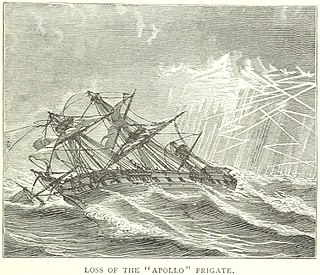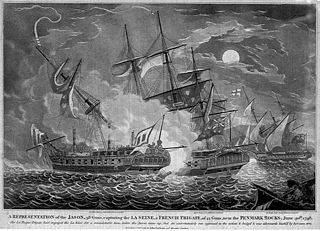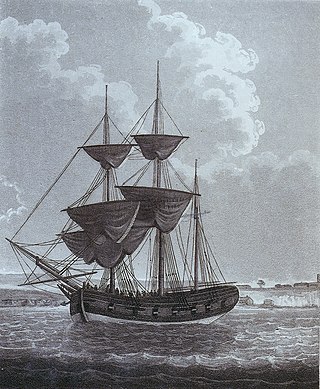
The first Alliance of the United States Navy was a 36-gun sailing frigate of the American Revolutionary War.

HMS Enterprise was a 28-gun sixth-rate Enterprise-class frigate of the Royal Navy. She was the name ship of her class of twenty-seven ships.

HMS Ajax was an Ajax-class 74-gun third-rate ship of the line of the British Royal Navy. She was built by John Randall & Co of Rotherhithe and launched on the Thames on 3 March 1798. Ajax participated in the Egyptian operation of 1801, the Battle of Cape Finisterre in 1805 and the Battle of Trafalgar, before she was lost to a disastrous fire in 1807 during the Dardanelles Operation.

HMS Hannibal was a 74-gun third-rate ship of the line of the Royal Navy, launched on 15 April 1786, named after the Carthaginian general Hannibal. She is best known for having taken part in the Algeciras Campaign, and for having run aground during the First Battle of Algeciras on 5 July 1801, which resulted in her capture. She then served in the French Navy until she was broken up in 1824.

HMS Apollo, the fourth ship of the Royal Navy to be named for the Greek god Apollo, was a fifth-rate frigate of a nominal 36 guns. She was the name ship of the Apollo-class frigates. Apollo was launched in 1799, and wrecked with heavy loss of life in 1804.
HMS Bedford was a Royal Navy 74-gun third rate. This ship of the line was launched on 27 October 1775 at Woolwich.
Coquille was a 40-gun frigate of the French Navy, lead ship of her class, and launched in 1794. The Royal Navy captured her in October 1798 and took her into service as HMS Coquille, but an accidental fire destroyed her in December 1798.
HMS Ariel was a 20-gun Sphinx-class sixth-rate post ship of the Royal Navy. The French captured her in 1779, and she served during the American Revolutionary War for them, and later for the Americans, before reverting to French control. Her French crew scuttled Ariel in 1793 to prevent the British from recapturing her.

Seine was a 38-gun French Seine-class frigate that the Royal Navy captured in 1798 and commissioned as the fifth-rate HMS Seine. On 20 August 1800, Seine captured the French ship Vengeance in a single ship action that would win for her crew the Naval General Service Medal. Seine's career ended in 1803 when she hit a sandbank near the Texel.

HMS Wolverine, was a Royal Navy 14-gun brig-sloop, formerly the civilian collier Rattler that the Admiralty purchased in 1798 and converted into a brig sloop, but armed experimentally. She served during the French Revolutionary Wars and participated in one action that won for her crew a clasp to the Naval General Service Medal. A French privateer captured and sank Wolverine on 21 March 1804 whilst she was on convoy duty.
HMS Nemesis was a 28-gun Enterprise-class sixth-rate frigate of the Royal Navy. The French captured her in 1795 at Smyrna, but in 1796 a squadron led by Barfleur brought her out of the neutral port of Tunis. Throughout her career she served under a number of commanders who would go on to have distinguished careers. She was converted to a troopship in 1812 and was sold in 1814.

HMS Circe was a 28-gun Enterprise-class sixth-rate frigate of the Royal Navy. She was launched in 1785 but not completed or commissioned until 1790. She then served in the English Channel on the blockade of French ports before she was wrecked in 1803.

HMS Rose was a 28-gun Enterprise-class sixth-rate frigate of the Royal Navy. Rose was first commissioned in August 1783 under the command of Captain James Hawkins.

HMS Siren was a 28-gun Enterprise-class sixth-rate frigate of the Royal Navy. Siren was first commissioned in August 1775 under the command of Captain Tobias Furneaux, her only commanding officer.

HMS Crescent was a 28-gun Enterprise-class sixth-rate frigate of the Royal Navy. Crescent was launched in 1779. The French captured her in 1781. She was wrecked in 1786.

HMS Arrow was a sloop-of-war in the Royal Navy that the Admiralty purchased in 1796. during the French Revolutionary Wars she participated in many actions, including one that resulted in her crew qualifying for the Naval General Service Medal. On 3 February 1805 she and Acheron were escorting a convoy from Malta to England when they encountered two French frigates. Arrow and Acheron were able to save the majority of the vessels of the convoy by their resistance before they were compelled to strike. Arrow sank almost immediately after surrendering, and Acheron was so badly damaged that the French burnt her.

The French frigate Aigle was launched in 1780 as a privateer. The French Navy purchased her in 1782, but the British captured her that same year and took her into the Royal Navy as the 38-gun fifth rate HMS Aigle. During the French Revolutionary Wars she served primarily in the Mediterranean, where she was wrecked in 1798.

Etna was a French naval Etna-class ship-sloop launched in 1795 that the Royal Navy captured in November 1796. She was taken into service as HMS Aetna and renamed to HMS Cormorant the next year. She captured several merchant vessels and privateers before she was wrecked in 1800 off the coast of Egypt.
Auspicious was launched at Newcastle in 1799 and was wrecked at Heneaga on 16 August 1801. She was part of a convoy sailing from Jamaica to England when strong, unsuspected currents drove her, five other merchantman, and one of their escorts, the frigate HMS Lowestoffe on to the shore.
Governor Trumbull was launched at Norwich, Connecticut in 1777 as a purpose-built privateer. There is no record of her having captured any British vessels but she did raid Tobago in 1779. The Royal Navy captured her shortly thereafter and took her into service as HMS Tobago. she served in the Leeward Islands until the Navy sold her in 1783, probably at Jamaica. She was apparently wrecked on 16 August 1787 at Tobago.














